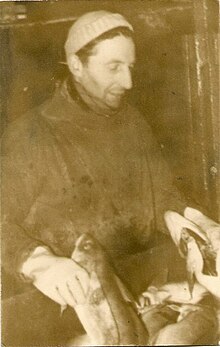
Fishing is the activity of trying to catch fish. Fish are often caught as wildlife from the natural environment, but may also be caught from stocked bodies of water such as ponds, canals, park wetlands and reservoirs. Fishing techniques include hand-gathering, spearing, netting, angling, shooting and trapping, as well as more destructive and often illegal techniques such as electrocution, blasting and poisoning.

Grimsby or Great Grimsby is a port town and the administrative centre of North East Lincolnshire, Lincolnshire, England. Grimsby adjoins the town of Cleethorpes directly to the south-east forming a conurbation. Grimsby is 45 mi (72 km) north-east of Lincoln, 33 mi (53 km) south-south-east of Hull, 28 mi (45 km) south-east of Scunthorpe, 50 mi (80 km) east of Doncaster and 80 mi (130 km) south-east of Leeds.

A fishing trawler is a commercial fishing vessel designed to operate fishing trawls. Trawling is a method of fishing that involves actively dragging or pulling a trawl through the water behind one or more trawlers. Trawls are fishing nets that are pulled along the bottom of the sea or in midwater at a specified depth. A trawler may also operate two or more trawl nets simultaneously.

The Arctic Corsair(H320) is a deep-sea trawler, built in 1960, that was converted to a museum ship in 1999. She is temporarily berthed at Alexandra Dock in Kingston upon Hull, England, pending completion of a new permanent location in the city's Museums Quarter. Exhibits and guides aboard the boat tell the story of Hull's deep-sea fishing industry.

SS Explorer is one of the last surviving sea-going steam trawlers and is registered to Leith, the port of Edinburgh. She has been placed on the National Historic Ships Register and the SS Explorer Preservation Society is currently restoring her in the Edinburgh Dock, Leith.

PS Lincoln Castle was a coal-fired side-wheel paddle steamer, which ferried passengers across the Humber from the 1941 until 1978. She was the last coal-fired paddle steamer still in regular services in the UK. Later, she served as a pub at Hessle, and then as a restaurant under permanent dock at Alexandra Dock, Grimsby. In September 2010, the Hull Daily Mail reported that she was in an advanced state of demolition, despite the efforts of local people to buy the historic vessel and restore her. On 31 March 2011, the Lincoln Castle Preservation Society were reported to have purchased the broken up parts of the ship for restoration.

The Grimsby Fishing Heritage Centre is a heritage attraction at Alexandra Dock, Grimsby, Lincolnshire, England, opened in 1991. The attraction is an Arts Council England Accredited Museum and holds a number of awards, including the TripAdvisor Hall of Fame, the Sandford Award for Heritage Education and the VisitEngland Quality Rose Marque. The centre was famed for its multi-sensory interpretation and lifelike manequins when it opened, winning the Attraction of the Year from the English Tourism Board and the Blue Peter Children's Museum of the Year award in 1993. It depicts the 1950s heyday of Great Grimsby's world famous fishing fleet, using displays consisting of preserved trawler interiors and carefully crafted recreations. The centre is also home to three historic fishing vessels. Perseverance is a sail trawler built in Boston Lincolnshire and is displayed in the main atrium of the museum. Ross Tiger is a 1957 side-trawler that is moored in the Alexandra Dock outside of the attraction. The G.I.C. or Esther is a large Grimsby sail trawler, built in 1888 at Alexandra Dock, close to the attraction.

A fishing vessel is a boat or ship used to catch fish in the sea, or on a lake or river. Many different kinds of vessels are used in commercial, artisanal and recreational fishing.

The Ross Group was a British food company founded in Grimsby, England in 1920.
Rinovia Steam Fishing Company Ltd. was a large fishing company operating from Grimsby, Lincolnshire, England. It specialized in deep-water fishing in the Icelandic grounds, and was responsible for handling Icelandic vessels landing their catch in Grimsby. It was also closely associated with the Icelandic consulate in Grimsby. Its trawlers bore a logo consisting of the fluttering flag of Iceland on their grey funnel.

A factory ship, also known as a fish processing vessel, is a large ocean-going vessel with extensive on-board facilities for processing and freezing caught fish or whales. Modern factory ships are automated and enlarged versions of the earlier whalers and their use for fishing has grown dramatically. Some factory ships are equipped to serve as a mother ship.

Fishing is a prehistoric practice dating back at least 40,000 years. Since the 16th century, fishing vessels have been able to cross oceans in pursuit of fish, and since the 19th century it has been possible to use larger vessels and in some cases process the fish on board. Fish are normally caught in the wild. Techniques for catching fish include hand gathering, spearing, netting, angling and trapping.

The Viola is a steam trawler built in 1906 at Hull. She is the oldest surviving steam trawler in the world. During her long career, she was known as HMTViola, Kapduen, and Dias. She is currently beached at Grytviken in South Georgia, though there are currently plans afoot to return her to Hull.

Aberdeen Harbour, rebranded as the Port of Aberdeen in 2022, is a sea port located in the city of Aberdeen on the east coast of Scotland. The port was first established in 1136 and has been continually redeveloped over the centuries to provide a base for significant fishing and ship building industries. Since the 1970s it has provided support to the offshore oil and gas industry operating in the North Sea and it is the main commercial port in the north east of Scotland.

Mincarlo is the last surviving sidewinder fishing trawler of the Lowestoft fishing fleet. She is also the last surviving fishing vessel built in Lowestoft, with an engine made in the town.

Koraaga was a Castle class steel-hulled trawler built in 1914 by Smith's Dock Company, South Bank, Middlesbrough. She was requisitioned as an auxiliary minesweeper operated by the Royal Australian Navy (RAN) in October 1917 for minesweeping duties during World War I, but she was never commissioned. Koraaga returned to be operated commercially as a fishing trawler until she wrecked when she struck a reef off Bass Point whilst carrying returning to Sydney. She was refloated on the tide after having becoming stranded and drifted till she was finally lost 5 miles east of Black Head, Gerringong on 10 September 1931.

The Port of Grimsby is located on the south bank of the Humber Estuary at Grimsby in North East Lincolnshire. Sea trade out of Grimsby dates to at least the medieval period. The Grimsby Haven Company began dock development in the late 1700s, and the port was further developed from the 1840s onwards by the Manchester, Sheffield and Lincolnshire Railway (MSLR) and its successors. The port has had three main dock systems:

Excelsior is an authentically restored fishing smack of the Lowestoft fishing fleet and a member of the National Historic Fleet. She was built by John Chambers of Lowestoft in 1921 and worked until 1936 before being converted into a motor coaster.</ref> In 2021 Excelsior will celebrate her 100th birthday. During her time as a motor coaster she was known as Svinør and worked mainly in Norwegian waters before returning to Lowestoft in 1972.

HMT Richard Bacon (FY3587) was a British Castle class naval trawler completed in 1918. She served through both world wars under two different names and also had a lengthy career as a civilian fishing trawler. For a short while, she functioned as a support vessel for a famous transatlantic flight by a group of Italian bombers. She was scrapped in 1954 after her boiler failed during a storm.

The Yorkshire coast fishery has long been part of the Yorkshire economy for centuries. The 114-mile (183 km) Yorkshire Coast, from the River Tees to the River Humber, has many ports both small and large where the fishing trade thrives. The historic ports at Hull and Whitby are important locations for the landing and processing of fish and shellfish. Scarborough and Bridlington are also sites of commercial fishing.

























